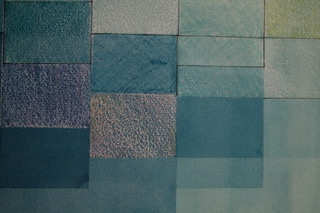
Three hour meeting bundles start at $700.
Start on a new journey today.

Three hour meeting bundles start at $700.
Start on a new journey today.
Sign up for our Muse-letter now!
“I have been playing seriously for as long as I can remember.”
— Ivan Barnett

As Ivan Barnett, I reflect here on “serious play” as the driving force behind my creativity and professional life. Inspired by artistic icons like Picasso, I learned the power of combining playful curiosity with disciplined skill. This document shares stories of my artistic journey, from experimenting with materials to co-founding Patina Gallery and my consultancy, Serious Play. Serious play is essential not only to artistic success but to achieving authenticity and innovation. It captivates others, and creates impactful work. Picasso once said that “every child is an artist.” Then he went on to say that it took him a lifetime to remain one.
My mother Annette was an arts educator and a stained-glass artist. My father, Isa Barnett, was a prominent Philadelphia artist. His paintings were cherished by many private collectors and are in the permanent collection of the New Mexico Museum of Art. I watched closely as a young boy in my father’s studio, learning the power of what brilliant design is in all things. No detail was missed, and no edge was ignored. It was always about design in its most abstract form. And nature was the ultimate teacher. “Son,” he said, “remember, there are no straight lines in nature.” After attending the University of the Arts, I served in the U.S. Army, then dedicated myself to life as a working artist.
Imagine growing up as one of his four children drawing, painting, and “making” in his studio. He’d even asked them to help work on a picture, in the spirit of creative collaboration. Of course, Picasso was a genius which also explains his drive to remain innocent. In spirit it took him four short years to master the technique of Raphael, something that few could do. As an aside, I met Paloma, his talented daughter in the 1980s, when she was a jewelry designer for Tiffany. Upon shaking her hand, I immediately transported toward her father’s eyes, those piercing and penetrating dark eyes! the eyes that changed the world of art forever, and turned “play into genius.”
My mother, Annette, was only 19 years of age when she brought me home from the hospital in Philadelphia. My parents married the year before. By this time Isa, my artist father, had joined the ranks of the “madmen and women” in America’s most creative ad agency, N.W. Ayer & Son. Isa was an amazing draftsman. He started daydreaming, as a boy sketching in the margins of his notebooks. He did this throughout his entire school life, right up until he enrolled at the famed Philadelphia Museum School of Art. Before long, this creative young man would graduate first in his class at art school. Then he set off for the heroic and dangerous world of the 82nd Airborne, months before D-Day.
No one’s quite looks when a child says “why not.” They are playing and having fun. Yet as an adult, that is somehow a different story. Those who do not lose the joy of creative play in their adult lives many times become the creatives that change the world.
Isa drove himself to become heroic, and for the rest of his life and mine, until he died. He was passionate about “heroes and heroines” for their willingness to experiment, play, and step into the unknown. In the face of uncertainty, we must have mentors, and, in our way, they become our living proof.
“To have all our senses enlivened is a really good thing, not only for the soul, but for the brain, the body, and our health. A notable New York Times article described how some doctors are writing prescriptions for patients to go to museums—literally writing prescriptions.” Ivy Ross
Now the stage was set for me, a toddler, to learn the “art of play” from my hero Isa Barnett. Looking back, I watched heroic serious play time and again. So, when it came to naming my new consultancy, it made perfect sense to call my practice Serious Play. Even before I knew about groundbreaking studies and work done in the realm of science about the nature of play and creativity.
Back to my childhood and playing seriously. Imagination and curiosity were my closest friends. I insisted on not growing out of the play sword fights in Knights of The Round Table costumes and acting the sheriff of my own western town built in a field behind my parents’ home. At 15 years old, I drew and painted, never told to grow out of any of it.
Imagine growing up from the time I could walk exposed to creative heroes that now you would only find in a James Michener novel or Oliver Stone film! Little did I know that I would be able to look back and see exactly why “playing seriously” became part of my DNA. By the time I headed toward art school, I had watched my father mentor and mentored by a cadre of mind-boggling adults who made a living playing extremely seriously. John Fulton, the American artist bullfighter, who went on to befriend Hemingway. Peter O’Toole and James Michener. Chuck Hayden, the art director cowboy from New Jersey. Paul Dyck, the painter who had a white buffalo grazing in front of his Arizona studio. Robert Riggs, the Philadelphia genius, painter who could draw like Da Vinci at 18.
Here is the thing, even the less famous of the creative characters along the way were still amusing themselves by adding daring “why nots.” They were all bigger than life to me. How could I not give myself permission to play seriously in my own career, when the time came? And they all were “playing” in their arenas and being successful at it! Why? Because they chose to be more and do more, and not fear the unknown, and it served them well.
Isa always gave me permission to play while at the same time insisted I’d learn proper technical skills to take play into disciplined art making. Permission was the key word here. Sometimes he’d even say “have fun” with something I was making. It took me 40 years to understand what he really meant. He was always saying let go and do, and play seriously, and you will be rewarded, and the career will come.
I found metal in 1978, and 40 years later it is still the material I love. I cut it, shape it, even paint on it. At other times I used discarded pieces of wood and other ephemera. I like finding objects that I can use to make abstract art. I like things that I can carve, that I can cut, that I can bend—pieces of found material that I can put together to make something more.
At 24, I had begun to play with “colored wax.” Could a 40-pound block of colored wax be more than a vocation? The answer was yes! I gave myself permission to make sculptures and keep playing as a business formed. I sat on the shoulders of Fritz Scholder and Alan Houser, Fulton the matador, and always my father, Isa Barnett. The Franklin Mint retained Isa to work with Houser, Scholder, Pablita Velarde, R.C. Gorman and other New Mexico luminaries.
Wax led to weather-vanes, led to mobiles, led to photography and led to Patina Gallery. By this time, my dear father had had a lifetime of heroic creative and brilliant creative friends. And yes, there were woman in the group, Star Dyck, Annette Barnett, and Mitzi Melnicoff. I watched them all, take their cues, and Patina would be my longest and grandest playground. For over two and a half decades, I would orchestrate the 2,000 square foot space as though it was one large collage. I knew my elders mentioned above would approve. I paid attention carefully, for decades.
Later in my life, as a gallery owner, the gallery I helped co-found, itself, was my studio when I was not actually making my own works. The objects in the gallery became collage-like elements for me to move around, recompose, reset, and re-stage. Sometimes, when I make a new work of art, time stops. I go to another transcendent place. Making something with my hands, deciding to do, then doing it is partly physical and partly spiritual. I’m in heaven when I make things. I actually feel younger. I lose track of time.
The gallery was an inspirational nexus. For those two and a half decades, it produced 275 exhibitions, each of them highly curated, some of them theatrical, operatic, costumed, or infused with haute couture. The artists whose work I helped curate at Patina Gallery encompassed so many complimentary elements. In an exhilarating alchemy, the artists talents liberated the skills of craftspeople. What I looked for, besides the spirit of play, wasn’t always easy to find—greatness. The question was what did greatness look like? To me, there are guiding principles woven together: the spirit of serious play, composition, proportion, scale, movement, and light. These are the same principles that determine greatness in music, architecture, and poetry.
“Brilliant Play attracts more brilliant play.” It is rarely an accident, and most of all it’s palatable, you can taste it. The great blues singer Janis Joplin once was asked when interviewed “how is it possible for you to deliver a performance that transcends beyond color, beyond race and beyond time? How do you do it?” I’m convinced that Janis was always playing very seriously when performing, as did Michael Jackson, as does Bruce Springsteen, and as does Taylor Swift! “What is it?” Janis’s answer to Dick Cavett when asked was this, “I get under the music.” And I would agree, Serious Play, is about giving us permission to get “under our play.” If we are lucky, magic will be ready to leap!
— Ivan Barnett
